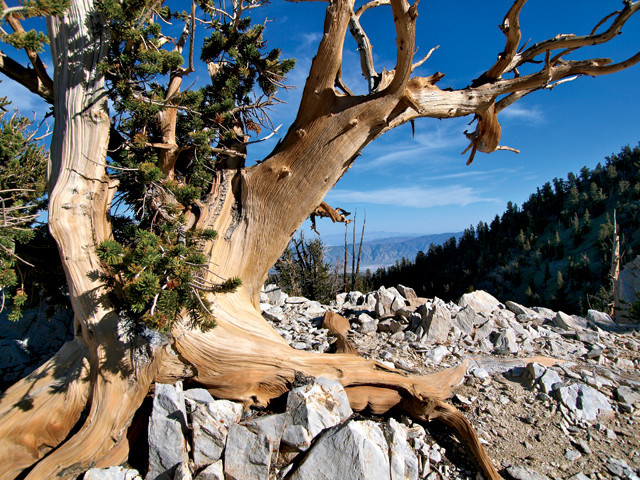
by Mary Caperton Morton Monday, November 2, 2015

Ancient trees, such as this 3,000-year-old Bristlecone Pine in Nevada, maintain records of past temperature changes in their growth rings. Credit: Mary Caperton Morton.
When Mount Pinatubo erupted in the Philippines in 1991, it sent a cloud of ash and sulfuric acid into the atmosphere that blocked incoming solar radiation and caused global temperatures to drop 0.5 degrees Celsius for three years. Quantifying such effects of prehistoric volcanic eruptions on climate, however, has long proved difficult due to inconsistencies in the proxies used to reconstruct atmospheric and temperature fluctuations. In a new study, scientists have used markers left by an unusual solar flare event to align ice-core and tree-ring records, enabling a more accurate accounting of the effects of volcanic eruptions in recent millennia.
Ice-core and tree-ring records are used to reconstruct atmospheric sulfate levels and temperature changes associated with volcanic eruptions. But establishing absolute dates for the relative sequences recorded in ice and tree rings is difficult. In 2012, a team from Japan identified a spike in radioactive carbon-14 in cedar tree rings dating from A.D. 775, which they attributed to a unique solar flare event — the only one known from the tree-ring record to have deposited such a spike. Subsequent studies identified the same spike in trees all over the world, including Germany, Siberia and Nevada’s Great Basin, giving dendrochronologists their first global marker for establishing absolute dates in tree rings.
In the new study, published in Nature, Michael Sigl of the Paul Scherrer Institute in Switzerland and his colleagues identified the same solar flare marker in 20 ice cores from Greenland and Antarctica. This enabled the team to align previously published atmospheric data from the ice cores with tree-ring temperature data, thus creating a more accurate time line for volcanic eruptions and subsequent cooling periods in the past 2,500 years.
“This is the first time that somebody has been able to link datasets from ice cores and tree rings and establish some hard dates for when these eruptions and cooling events occurred,” says Scott Rutherford, a geologist at the University of Rhode Island in Narragansett who was not involved in the new study. “It’s really a big step forward.”
Once aligned, the ice-core and tree-ring datasets showed that 15 of the 16 coldest summers recorded between 500 B.C. and A.D. 1000 followed large volcanic eruptions, with four of the coldest years occurring shortly after the largest volcanic events.
“Using the new records, we showed that large volcanic eruptions in the tropics and high latitudes were the dominant drivers of climate variability, responsible for numerous and widespread summer cooling extremes over the past 2,500 years,” Sigl says. Previously, ice-core records of atmospheric changes brought on by volcanic eruptions had been misdated by about five to 10 years, making it difficult to assess how past eruptions led to the temperature changes recorded in tree rings.
The new study helps explain historical records of unusually cool summers, crop failures and famines that may have resulted from volcanic eruptions on the other side of the planet. For example, two large volcanic events that were originally dated at A.D. 529 and 533 didn’t seem to have triggered any cooling, although there was a 15-year cooling period from 536 to 550 that didn’t have any eruptions associated with it. The “new dating shows the [eruption] events actually happened in 536 and 540 with the cooling period occurring just afterward,” Sigl says.
However, other mysteries remain. Ice-core records indicate that an eruption occurred somewhere in the world in 1257, but tree-ring data don’t record any associated cooling episodes. “What was different about that eruption? Or is there something off about the temperature reconstruction?” Rutherford asks. To answer those questions, Sigl’s team will need to gather additional tree-ring data from more locations around the world to better fill out the record of global temperature responses to eruptions," he says.
Sigl and colleagues are also planning to extend their records further in time by sourcing ice-core records from Antarctica that go back 10,000 years. “With new high-resolution records emerging from ice cores in Greenland and Antarctica, it may be possible to extend this reconstruction of volcanic forcing all the way back into the last ice age,” he says.
The ongoing project may do more than fill in our knowledge of the effects of past eruptions on climate; it may also enable scientists to make predictions about the effects of future eruptions, Sigl says. “Large eruptions could affect everything from temperature to food production, so it’s important to gather as much information as we can on how climate responds.”
© 2008-2021. All rights reserved. Any copying, redistribution or retransmission of any of the contents of this service without the expressed written permission of the American Geosciences Institute is expressly prohibited. Click here for all copyright requests.